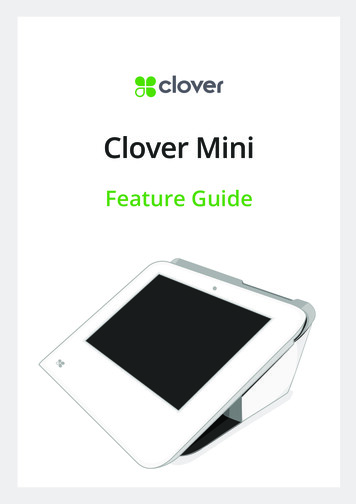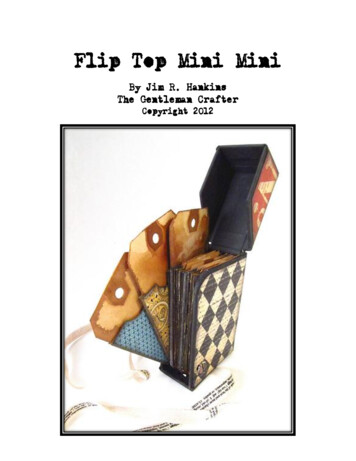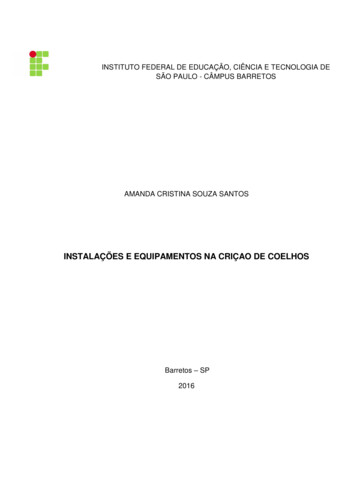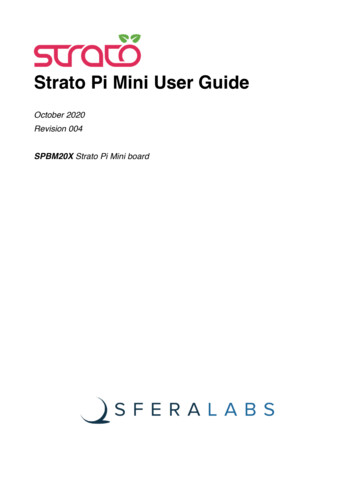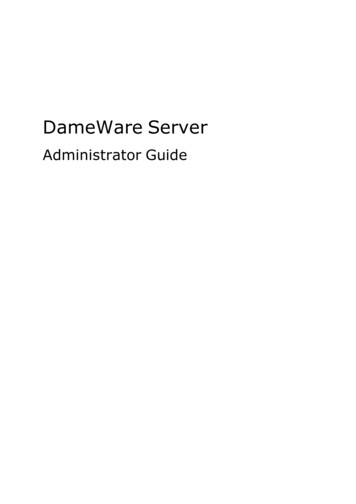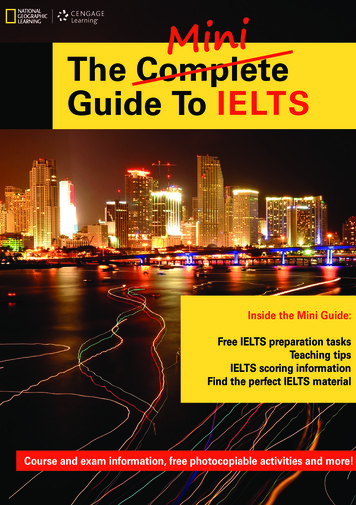
Transcription
MiniThe CompleteGuide To IELTSInside the Mini Guide:Free IELTS preparation tasksTeaching tipsIELTS scoring informationFind the perfect IELTS materialCourse and exam information, free photocopiable activities and more!
Welcome to The Mini Guide To IELTSOverview of The Complete Guide To IELTSThe Complete Guide To IELTSDear Teacher,Bruce Rogers & Nick KennyTo celebrate The Complete Guide To IELTS we have created The Mini GuideTo IELTS, a useful pocket-sized guide filled with handy photocopiable tasks,teaching tips and more!The sample tasks in this mini guide are taken from The Complete Guide ToIELTS and are designed to be used as part of a sequence that deconstructsthe skills involved in each task type so they aren’t truly standalone.However, they do make fantastic practice for any IELTS student!We hope you enjoy using them.Happy teaching!The Team at National Geographic LearningTop Tips forTeaching IELTSAn overviewof The CompleteGuide To IELTSIELTSpreparationtasksWhat’s inside theMini Guide To IELTs?Informationabout IELTSscoringInformation aboutthe Academic andGeneral TrainingexamsFind the IELTSmaterial that isright for you!Bands 5.5 - 7 Try out some of thepreparation tasks fromThe Complete Guide ToIELTS inside this handymini guide!CEFR: B2 – C1The Complete Guide To IELTS deconstructs the IELTS test and workssystematically through each paper, covering all task types, text typesand skills. No stone is left unturned. The material can be used inclass or by students working on their own. Each lesson offers task analysis, sample questions, tips and tactics,and skills-building exercises Separate vocabulary lessons deal with the common lexical featuresand topics of the IELTS reading passage types and listening sections Engaging and motivating National Geographic video lessonsincrease students’ familiarity with the listening task types A Language Resource Bank provides a comprehensive grammar reference and practice exercises coveringall the grammar needed for the test Speaking Test videos and worksheets build students’ confidence by showing real students completing fullIELTS Speaking test interviews Contains a full practice testFor Students:For Teachers:Student’s Book DVD-ROM Access CodeInteractive Student’s eBookTeacher’s Book DVD-ROM Class Audio CDIntensive Revision Guide Interactive WhiteboardIntensive Revision GuideEvery Student’s Book contains a code giving free access to online practice. In the days running up to theexam, students can focus intensively on eliminating mistakes that will cause them to throw away marks.The Intensive Revision Guide sensitises students to common pitfalls, then drills them in how to avoid them.It covers the following areas:ListeningSpelling mistakesNumbers, dates and timesSingular or plural?Not following instructionsProblems with mapsBackground knowledge isdangerous!Jumping to conclusionsNot using the timeeffectivelyReadingSpelling mistakesNot following instructionsJumping to conclusionsUsing the wrong strategiesCareless readingIncomplete readingMissing clues in questionsGrammar mistakesWritingIncluding too much detailNot identifying the mainideaUsing the wrong tensesNot answering the questionNot giving supportingexamplesUsing the wrong registerRepeating words from thequestionIncohesionSpeakingFeeling nervousNot answering the questionNot using planning timeUsing the wrong tensesOver-complicating youranswerNot extending your answerRepeating yourselfGrammar mistakesCan also be used on a tablet!1
Top Tips for Teaching IELTS from the authorsof The Complete Guide To IELTSIELTS ScoringFormat of the Academic and General Training IELTS examsBruce Rogers is a writer,teacher and editor, who haswritten and co-written severalpopular exams textbooks.4 sections (30 minutes 10 minutes transfer time)Reading: AcademicReading: General Training3 texts (60 minutes)3 sections (60 minutes)Writing: AcademicWriting: General Training2 tasks(Task 1 20 minutes/Task 2 40 minutes)2 tasks(Task 1 20 minutes/Task 2 40 minutes)Speaking: Academic and General Training3 sections (11-14 minutes) The IELTS exam is scored according to a 9-Band scale. You will get a score for eachsection. The average of these 4 marks is your Overall Band Score. The total test time is 2 hours 45 minutes. The first three modules - Listening, Readingand Writing - must be completed in one day. The Speaking Module may be taken, at thetest centre’s discretion, in the period seven days before or after the other Modules.Adapted from Exam Essentials Practice Tests 2: IELTSOverview of how IELTS maps to the CEFRCommon European Framework of Reference (CEFR)A1A2B1B2C1C2IELTS424.55 5.5 6 6.57Nick KennyBruce RogersListening: Academic and General Training7.589Nick Kenny is anestablished EFL author,specialising in preparation andpractice materials for the University ofCambridge examinations.sGeneral TipPrepare your students with practice testsunder exam-like conditions, following thetime limits for each section of the test.Be sure your students are familiar with theformat of the test; encourage them to have aclear ‘map’ of the test in their mind.sSpeaking TipMake sure your students don’t give memorisedanswers or try to prepare their answer beforethe test, remind them to remain confident andrelaxed.sReading TipReassure students that they do notneed to understand every detail and itdoesn’t matter if there are words theyare not familiar with.Familiarise your students with the format ofthe many question types and make sure theyunderstand the importance of reading theinstructions for each set of questions carefully.sListening TipHighlight the importance of reading thequestions carefully - encourage your studentsto try to predict what kind of information theywill need to answer the questions.sWriting TipDon’t begin writing immediately! Train yourstudents to always organise their thoughtsand make notes before beginning to write.Find more great tips inThe Complete Guide To IELTSEncourage students not to give shortanswers to questions or respond with asimple yes or no but to give details andexamples when they speak.Spelling counts! Remind your studentsthat when transferring their answers tothe answer sheet they should check theirspelling carefully.Ensure students know not to copy longphrases or sentences from the writingprompt but to use their own words.3
11 It’s especially important to check carefully whether an answer is FALSE or NOT GIVEN.12 Remember to write the words TRUE, FALSE or NOT GIVEN in the boxes on theanswer(n) studentdormitorysheet.accommodationTASK 1 BAR CHARTS13 Never leave a box empty. If you’re not sure, always give an answer.provided by aSample Academic Reading TaskSample Writing TaskuniversityD Skills-building exercisesThe chart below provides information about student accommodation at one USuniversity in 2013.55 A The book Apicius includes recipes that are still in use today.B The book Apicius includes recipes for dishes that are familiar Owried91 What is the overall idea of the chart?2 What are two important points about undergraduate student accommodation?Whatare twoimportantpointsinaboutgraduatestudent accommodation?1 3Writean introductorystatement(based on the informationthe text boxabove the200ACADEMIC WRITINGchart) and describe the overall idea or main trend shown in the chart in paragraph dation.make between undergraduate and graduate24Writetwo or threeimportantabout undergraduate3 Write two or three important points about graduate student accommodation.studentaccommodation?4 Comparethe informationabout graduate and undergraduate student accommodation.4 What points of comparison can you make between undergraduate and graduate studentaccommodation?9relevant to each pair of statements in Exercise 4.Now write your answer. (10–15 minutes)Give examples to support your answer.106 Go through the questions in Exercise 4 one by one. Read the passage carefullyand decide which statement (A or B) is TRUE and which is FALSE.117 Work in pairs and answer these questions.200Try out this sample Academic Reading task from The Complete Guide to IELTS. Thereading passage can be found at NGL.Cengage.com/eltexampreparation411carefully at the chart and the instructions and answer the questions. (3–5 minutes)8LookLook carefully at the chart and the instructions and answer the questions.1 What is the overall idea of the chart?Go throughthequestionsin Exercise 4 one by one. Read the passage carefullyand TBCCaption2 Whatare twoimportant points about undergraduate student accommodation?(3–5minutes)3 What aretwo important pointsgraduatestudent accommodation?decide whichstatement(Aaboutor B)is TRUEand which is FALSE.5 Read the passage quickly. Underline the sentences that contain the information1 Did you and your partner underline the same sentences in the passage?2 Are your answers all the same?3 Discuss why the TRUE statements are true and the FALSE statements are not.Compare your ideas with another pair.nGraduate studentsIdentifying theimportant pointsand key features ofa bar chart6 A The ingredients used in the recipes tell us the type of people the book Apiciuswas intended for.78ACADEMIC READINGB The book Apicius uses ingredients that were commonly available in Ancient Rome.Owand key features ofin 2013.Read the passage on page 79 quickly. Underline the sentencesuniversitythat containthea bar chartinformation relevant to each pair of statements in Exercise 4.Focus6Undergraduate students810arprovided by auniversity9M4 A It is widely thought that Marcus Gavius Apicius wrote the recipes in Apicius.B It is widely doubted that Marcus Gavius Apicius wrote the recipes in Apicius.apartmUniversitydormitory3 A Apion’s book about Marcus Gavius Apicius is no longer available to read.B Apion’s book about Marcus Gavius Apicius is still popular today.parents2 A The book Apicius provides plenty of information about the life of Marcus GaviusApicius.B The book Apicius provides very little information about the life of Marcus GaviusApicius.Shared1 A The recipes in the book Apicius are much older than thebook itself.B The recipes in the book Apicius are 1,500 years old.Identifying the45001 A The recipes in the book Apicius are much older than the book itself.important points4000B The recipes in the book Apicius are 1,500 years old.and key features of2 A The 3500book Apicius provides plenty of information about the life of Marcus Gaviusa bar chartApicius.3000B The book Apicius provides very little information about the life of Marcus GaviusGLOSSARy2500Apicius.dormitory (n) student3 A Apion’s2000 book about Marcus Gavius Apicius is no longer available to read.accommodationB Apion’s book about Marcus Gavius Apicius is still popular today.1500provided by a4 A It is widely thought that Marcus Gavius Apicius wrote the recipes in Apicius.university1000B It is widely doubted that Marcus Gavius Apicius wrote the recipes in Apicius.5 A The bookApicius includes recipes that are still in use today.500B The book Apicius includes recipes for dishes that are familiar today.06 A The ingredients used in the recipes tell us the type of peoplethechartbookprovidesApicius FocuswasThisintended for.GLOSSARyinformation aboutstudentIdentifyingthedormitory (n) studentBThe book Apicius uses ingredients that were commonly availablein AncientatRome.accomodationone USpointsimportantaccommodationWithimportant words and ideas in each statement.Identifying true andfalse statementsbased on a shortpassage8Read the pairs of statements (1–6). Underline the important words and ideas in Focuseachstatement.Student accommodation 2013Number of students4 Read the pairs of statements (1–6). Underline the4FoCuSSkills-building exercisesPlease note, these sample tasks are part of a sequence that deconstructs the skillsinvolved in each task type, so aren’t truly standalone. However, they do make greatpractice for your IELTS students!ACADEMIC WRITING9CheckNowwriteyouranswer.your work.Look formistakesin spelling, (10–15punctuationminutes)and grammar. Make sure10you have used comparative and superlative forms correctly, and used a good variety oflanguage to describe charts. (3–5 minutes)1 Write an introductory statement (based on the information in the text box next to theWork inpairs. Afteryou havefinished, lookthe model answerthe mainanswer keyonchart)anddescribetheat overallideainortrendshown in the chart in paragraph 1.the DVD-ROM. Compare your answers with the model answer and think about themarkingcriteria.two(See pagefor markingcriteria.)2 Writeor180threeimportantpoints about undergraduate student accommodation.113 Write two or three important points about graduate student accommodation.4 Compare the information about graduate and undergraduate student accommodation.10 Check your work. Look for mistakes in spelling, punctuation and grammar. Makesure you have used comparative and superlative forms correctly, and used a goodvariety of language to describe charts. (3–5 minutes)200ACADEMIC WRITING11 Work in pairs. After you have finished, look at the model answer in the answer key.Compare your answers with the model answer and think about the marking criteria.The accompanying answer key and marking criteria for this task can be found atNGL.Cengage.com/eltexampreparation5
5Sample Listening TaskSkills-building exercises4 Read the sentences (1–4). What type of information isFoCuSIdentifying thetarget informationD Skills-buildingexercisesPART 14missing in each of the gaps?12345You could see a total of . motorcycles at the museum when it first opened.There was a . at the museum in the year 2003.The speaker mentions the up-to-date . facilities in the conference centre. 5The museum’s oldest two-wheeled bike was built in the year . .06 Look at the sentences (1–4). Listen again and complete the sentences. Useyour answers from Exercise 5 to help you. Write NO MORE THAN TWO WORDSAND/OR A NUMBER for each answer. 7tIPOne simple wayRead the sentences (1–4). What type of information is missing in each of the gaps?to give yourself2 Look at the example Part 1 topics. Write three or four1 You couldsee a totalof each topic thatmotorcyclesat themightmuseumlittle extra timequestionsaboutan examineraskwhen it firstaopened.2 There was aat the museum in the year 2003.is to repeat partinPart1.3 The speaker mentions the up-to-datefacilities in the conference centre.of the examiner’s4 The museum’soldest two-wheeled bike was built in the year. question, but bePart 1 topicscareful not to do1 Work or study06 Listen to a short talk about about a motorcycle museum and make a notethis oftoo often.2 Favourite placethis information:3 Daily routine6a . What would you like to change about your daily routine?346SPEAKING06 Look at the sentences (1–4). Listen again and complete the sentences.Useb . Tell me about a typical weekday for you.your answers from Exercise 5 to help you. Write NO MORE THAN TWO WORDS AND/c .forIs therea balance between your work time and your leisure time in your dailyOR A NUMBEReach answer.12347routine?You could see a total ofmotorcycles at the museum when it first opened.d . Do you work or study betterin the morning or the afternoon?There was aat the museum in the year 2003.The speaker mentions the up-to-datefacilities in the conference centre.5 Work inoldestpairs.two-wheeled bike was built in the yearThe museum’s.1 Write your answers to the questions in Exercise 4.06 Listen again and look at the audioscript on the DVD-ROM. Think about why2 Practise asking and answering the questions with your partner.the answers to the questions in Exercise 6 are correct, and why other words andnumbers you hear are not the correct answers.1234You could see a total of . motorcycles at the museum when it first opened.Watch Part 1 again. What does Lena say when she needs a little more time to6There was a . at the museum in the year 2003.8 Work in pairs.Lookat examiner’sthe sentencesand photo below. What type of information isanswerthequestions?The speaker mentions the up-to-date . facilities in the conference centre.missing in each of the gaps?The museum’s oldest two-wheeled bike was built in the year . .7 Look at the phrases that you can use to give yourself some extra time to think about706 Listen again and look at the audioscript. Think about why the answers to thequestions in Exercise 6 are correct, and why other words and numbers you hear arenot the correct answers.Work in pairs. After you have finished, look at the model answer in the answer key.Compare your answers with the model answer and think about the marking criteria.The accompanying material for this activity can be found atNGL.Cengage.com/eltexampreparation661 You hear information about the number of motorcycles in the museum at differenttimes.down Partthe numbershear. test interview. Tick ( ) any questions the examiner1 of the youSpeaking3 WriteWatch2 You hear three dates when things happened at the museum. Write down the thingsuses that are the same as the ones you wrote in Exercise 1.that happened.3 You hearaboutfacilitiesaboutfor visitorsat theroutine.museum.CanWhichfacilitiesthedoorder the4 Lookatdifferentthe questionsyour dailyyouthreerememberyou hearexaminerabout? asked them in? Number the questions in the correct order.CaptionTBCThenwatch the4 You hear about old motorcycles in the museum and when they were built. Write downvideoandcheckyouranswers.three years you hear.06 Listen to a recorded message about a motorcycle museum and make a note ofthis information:1 You hear information about the number of motorcycles in the museum at differenttimes. Write down the numbers you hear.2 You hear three dates when things happened at the museum. Write down the thingsthat happened.3 You hear about different facilities for visitors at the museum. Which three facilities doyou hear about?4 You hear about old motorcycles in the museum and when they were built. Write downthree years you hear.6Sample Speaking TaskTaSk TypE 1 Sentence Completionyour answer to the examiner’s question. Unscramble the phrases and write thewords in the correct order. Use the capital letters and punctuation to help you.1234let uh, now see Hmm, me .an that’s interesting Oh, question .it’s Well, to hard but say, .I you Well, know, guess .The accompanying video for this speaking task can be found atNGL.Cengage.com/eltexampreparation7
Find the IELTS material that’s right for you!What are you looking for?Skills Practicewith keyExam Practice1Exam Essentials Practice Tests 1 with keyEXAM ESSENTIALS PRACTICE TESTSIELTSThe Exam Essentials Practice Tests series provides students with an invaluablecombination of exam information, task guidance and up-to-date exam practice. The tests arewritten by experts in the field, and are at least the same level as the real IELTS exam. Studentscan be confident that if they do well in the Practice Tests, they’ll do well in the real exam.Photocopiable MaterialPreparation CourseWhat band are you looking for?EXAM ESSENTIALS PRACTICE TESTSIELTSwith key13.5 - 4.5The tests offer practice in all four Modules of the exam: Listening, Reading, Writingand Speaking.IELTS An Audio script of all the recordings includes underlined sections to show where theanswers can be found.IELTS A DVD-ROM containing video of a complete model Speaking interview with usefultips from examiners and accompanying worksheet allows students and teachers to seeexactly what the Speaking test entails. Exam-style Audio recordings on the DVD-ROM give students an authentic taste of theListening paper.DVD-ROMIncludes video ofcomplete Speakinginterview and tips2Bridge toIELTSPre-intermediate – Intermediate Band 3.5 to 4.5WorkbookLouis RogersBRIDGEtoIELTS WB Cover Template.indd 1Pre-intermediate – Intermediate Band 3.5 to 4.5Six complete practice tests cover a wide range of typical exam topic areas.Task guides and Step-by-step guides in Tests 1 and 2 explain how best to approach eachtask type and give guidance on typical exam questions. Additional Task and Step-by-stepguides are provided for all Writing modules.COBUILDCOBUILDIllustrated Intermediate Dictionary of English, Second Edition detailed guidance and essential tipsNational Geographic Learning, a part ofCengage Learning, is a leading provider ofmaterials for English language teachingand learning throughout the world.Visit elt.heinle.com unique DVD-ROM with complete Speaking interview and tips from examiners model answers for all writing tasks and additional task guide in all testsCOBUILDDictionaryCOBUILD EnglishEng lishCOBUILDEnglishEnglishCOBUILDCOLLINS CORPUSthe world’s first and largestlanguage databaseDictionaryIncludes video ofcomplete Speakinginterview and tipsKey featureWhat does it do?IELTS-orientated,topic-based unitsImmerses students in engaging topics that providethe context for learning about: academic life,language, skills work and the IELTS test.See pages 00-00Integrated skillslessonsDevelop students’ reading, writing, listening andspeaking.See Unit X 000A step-by-step guide toa high IELTS speakingand listening scoreHere’s an exampleIntermediateCoBuild DictionaryBridge toIELTSTeaches students key functional language they willneed in the speaking test.See page 000Provides extra opportunities to prepare for thespeaking test.See page 000Bridge to IELTSTeaches students how to recognise and then performIELTS task types, e.g. guided summary completion.See page 000GrammarreferenceGives clear summaries of key grammar pointsas well as additional practice activities.See page 000LevelsLevel 1General descriptorsCEFCambridge ESOL examsElementary to Pre-intermediateA1–A2KETLevel 2Low Intermediate to IntermediateA2–B1PETLevel 3Intermediate to Upper IntermediateB1–B2FCEOrganisation of Practical GrammarEach level of Practical Grammar has 100 units, divided into modules of five units. Each module examines a particular areaof grammar. The grammar is set in short, everyday conversations or texts, showing the language in natural situations whichstudents will find engaging and can relate to.Students then examine the form, meaning and use of the language before practising it in a variety of activity types.A Review section concludes each module and regular tests check students’ progress.Each level comes with two audio CDs and a pin code which allows access to MyPG for extensive additional online practicefor use at home or in self-access centres.Key featuresReal language in natural situations: exposes students to grammar at workListening and pronunciation: two audio CDs provide listen and check supportand key pronunciation of the grammar itemsKey vocabulary: high frequency words and expressions in each unitSee page 72See page 91See page 24Tips: highlight common errors and characteristics of English GrammarSee page 56Regular review and progress tests: give students the opportunity to checktheir learningSee page 20 for a reviewSee page 230 for a progress testEach level of Practical Grammar is available in two editions: with or without answers.Level 1 with answersLevel 1 without answersLevel 2 with answersLevel 2 without answersLevel 3 with answersLevel 3 without answersGet students to revisit and reuse the grammar andvocabulary they have worked with.See pages 000Study SkillsHelps students to thinking about how they learnand how to become more effectively learners.See page 000Writing bank12 ‘Writing’ lessons get students to analyse basic textsSee page 000and use them to develop their own writing skills.ISBN 978-1-4240-1808-6ISBN 978-1-4240-1677-8ISBN 978-1-4240-1805-5ISBN 978-1-4240-1804-8ISBN 978-1-4240-1807-9ISBN 978-1-4240-1806-2Student’s BookLevel 1Practical Grammar is a three-level British English Grammar course for self study or use in the classroom. The series takesstudents through key aspects of English grammar from Elementary to Upper Intermediate levels.Living IELTSDiscussionRegular reviewsNational Geographic Learning, a part of Cengage Learning, provides customers with a portfolio ofquality materials for PreK-12, academic, and adult education. It provides instructional solutions forEFL/ESL, reading and writing, science, social studies, and assessment, spanning early childhoodthrough adult in the U.S. and global markets. Visit NGL.Cengage.com6-7PRACTICALGRAMMARDavid Riley and John HughesRiley and HughesChris GoughSusan Hutchison1/10/12 10:06 AMPRACTICAL GRAMMARDVD-ROMSKILLSDictionaryLevel 1NEWLISTENINGSecondEditionSecond EditionDictionaryEnglishCollins COBUILD Dictionary FINAL 010912.indd 1 Exam-style Audio recordings on the DVD-ROM give students an authentic taste of theListening paper.SPEAKING &900009 781133 314158EnglishBridge to IELTS Student’s Book A DVD-ROM containing video of a complete model Speaking interview with usefultips from examiners and accompanying worksheet allows students and teachers to seeexactly what the Speaking test entails. two General Training IELTS testsEnglishofD i c t i o n a r y English An Audio script of all the recordings includes underlined sections to show where theanswers can be found. Full-sentence definitions use the most common context in which targetwords are found in real life. Grammatical patterns shown in context help the learner to use Englishaccurately and naturally. Natural English examples from the Collins Corpus show the user words asthey appear in everyday English.English An annotated Answer key contains detailed answers for each task, with explanatorynotes and some additional information on incorrect answers.COBUILD promotes learning through Definitions PLUS:More than 160 illustrated features to enhance yourlearning experienceDictionaryCOBUILDThe new, free mobile app for the iPhone, Android, and mobile web browserswill allow you to access concise definitions and examples, and hearpronunciation quickly. For more details visit mobile.heinle.com.You can trust Collins COBUILDAll of our explanations, examples and special features are based on ourconstantly updated 4.5 billion-word database of today’s English language,the Collins Corpus. This means that you can trust Collins COBUILD to help youspeak and write accurate and up-to-date English. six complete Academic IELTS testsIllustrated IntermediateDictionary ofMore than 55 new words have been added to the new Collins COBUILDIllustrated Intermediate Dictionary of English. Exam overview gives an at-a-glance summary of the format and task types of eachpaper in the exam.4.5 - 7Pre-intermediate – Intermediate Band 3.5 to 4.5COBUILDBridge to IELTS is specially designed for students planning to take an IELTSpreparatory course in the future. The course bridges the gap between generalEnglish and the IELTS test and helps students to: build a solid grammar and vocabulary base develop reading, writing, speaking and listening skills understand how the IELTS exam works by doing IELTS-type tasks and practiceactivities develop key study skillsBy successfully completing this course students will be able to move confidentlyinto an IELTS preparation course such as Achieve IELTS or IELTS Express.The new Visual Thesaurus helps learners develop fluency by providingalternatives to the 50 most over-used words in English.IELTS Practice Tests also includes a complete support scheme for both students andteachers:3/14/12 10:23 AMBridge to IELTS WorkbookStudent’s BookThe General Training section provides additional Reading and Writing Modules for two tests.ISBN-10 1-4240-1677-0ISBN-13 978-1-4240-1677-8How long have you got?with audio CDsHeinle, a part of Cengage Learning, is a leading provider of materials for English languageteaching and learning throughout the world.Visit elt.heinle.comPractical Grammar Level 1How long have you got?Louis HarrisonSusan HutchisonNational Geographic Learning, a part of Cengage Learning, publishes materials forEFL/ESL, reading and writing, science, social studies, and assessment, spanningearly childhood through adult. Visit ngl.cengage.comJON MARKSBruce Rogers and Nick KennyThe Complete Guide To IELTS deconstructs the IELTS test and workssystematically through each paper, covering all the task types, text types andskills. No stone is left unturned.The material can be used in class or by students working on their own.KEY FEATURES Separate Vocabulary lessons deal with the common lexical features of the IELTSreading passage types and listening sections. A Language Resource Bank provides a comprehensive grammar reference andpractice exercises covering all the grammar needed for the test.Student’s BookISBN 9781133315568 a full audioscript of the listening exercises included in the Class AudioCDsAchieve IELTS 1 Class Audio CDs(2 CDs), Second EditionSecond EditionISBN 9781133313854Richard Hallows Martin LisboaHeinle, a part of Cengage Learning, is a leading provider of materialsfor English language teaching and learning throughout the worldVisit elt.heinle.comINCLUDESCOMPLETEPRACTICETESTHeinle, a part of Cengage Learning, is a leading provider of materialsfor English language teaching and learning throughout the worldVisit elt.heinle.comFor more information about any of these titles please visit NGL.Cengage.comFor Delta titles visit www.deltapublishing.co.ukRichard Hallowshas been a teacherand teacher trainerfor over 20 years.During this time hehas worked in severaluniversities in the UKteaching EAP, IELTS, and teachingmethodology to international studentson masters, pre-masters courses, andteacher-training courses. Richard’sexperience includes developing anddelivering the Extended Masters inManagement programme at theUniversity of Brighton. He has
IELTS Speaking test interviews Contains a full practice test Dear Teacher, To celebrate The Complete Guide To IELTS we have created The Mini Guide To IELTS, a useful pocket-sized guide filled with handy photocopiable tasks, teaching tips and more! The sample tasks in this mini guide are taken from The Complete Guide To

